Automotive Steering Motor Market Size 2024-2028
The automotive steering motor market size is forecast to increase by USD 456.2 million, at a CAGR of 4.5% between 2023 and 2028.
Major Market Trends & Insights
- APAC dominated the market and accounted for a 57% growth during the forecast period.
- By the Application - Passenger car segment was valued at USD 1059.40 million in 2022
Market Size & Forecast
- Market Opportunities: USD 41.28 million
- Market Future Opportunities: USD 456.20 million
- CAGR : 4.5%
- APAC: Largest market in 2022
Market Summary
- The market is experiencing significant advancements, driven by the continuous integration of electric and electronic systems into vehicle design. According to recent studies, the market's value is projected to expand at a steady pace, with increasing demand for fuel efficiency and improved driving dynamics. For instance, electric power steering (EPS) systems are gaining popularity due to their energy savings and enhanced driving experience. In fact, EPS systems are expected to account for over 90% of the market share by 2025.
- Additionally, the market is undergoing cost pressure from the demand side due to the increasing adoption of advanced driver-assistance systems (ADAS) and electric vehicles (EVs). These factors contribute to the evolving landscape of the market, making it an essential component in the development of future mobility solutions.
What will be the Size of the Automotive Steering Motor Market during the forecast period?
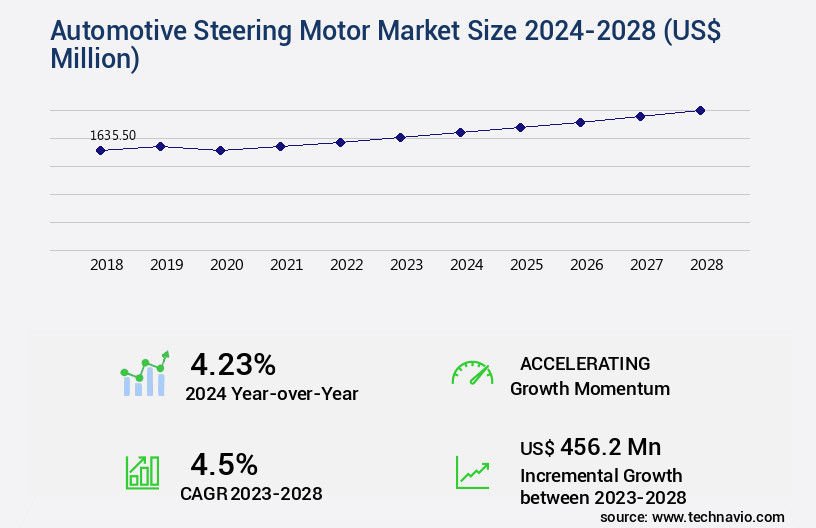
Explore market size, adoption trends, and growth potential for automotive steering motor market Request Free Sample
- The market continues to evolve, driven by advancements in technology and consumer demand for enhanced safety features and improved fuel economy. Two key trends shaping the market are cost optimization and response time. A high-torque motor, implemented through careful material selection and assembly techniques, enables quicker steering performance. In contrast, a low-noise motor prioritizes quality assurance and manufacturing process refinements to meet automotive safety standards. For instance, the latest high-torque motor design reduces system latency through PWM control and torque ripple reduction, while the low-noise motor employs noise cancellation techniques and safety mechanisms to ensure a quiet and reliable driving experience.
- These advancements contribute to the overall system reliability, resulting in a more precise and fuel-efficient steering system. Moreover, driver feedback plays a crucial role in the development of automotive steering motors. Testing protocols are rigorously implemented to ensure steering stiffness and power consumption remain optimized, while motor driver ICs are designed to minimize energy consumption and improve overall system efficiency. By focusing on both performance and cost optimization, the market continues to advance, providing significant benefits to both manufacturers and consumers.
How is this Automotive Steering Motor Industry segmented?
The automotive steering motor industry research report provides comprehensive data (region-wise segment analysis), with forecasts and estimates in "USD million" for the period 2024-2028, as well as historical data from 2018-2022 for the following segments.
- Application
- Passenger car
- Commercial vehicle
- Geography
- North America
- Europe
- APAC
- Rest of World (ROW)
By Application Insights
The passenger car segment is estimated to witness significant growth during the forecast period.
In the automotive industry, passenger cars represent the largest market segment in terms of both value and volume. The expansion of this sector is indicative of a country or region's economic growth and development. Asia is poised to emerge as a significant player in the passenger car market due to its burgeoning middle class population. The increasing demand for passenger vehicles in emerging economies, including China, Brazil, and India, is fueled by economic growth and rising consumer purchasing power. This trend is driven by ongoing industrialization and global trade activities in these regions. Automotive steering motors play a crucial role in enhancing the functionality and efficiency of various steering systems.
Fault detection and current sensor technologies enable real-time monitoring and analysis of motor performance. Steering feel tuning and sensor calibration ensure an optimal driving experience. Active steering systems and fail-operational systems provide enhanced safety and reliability. Column assist motors, hall effect sensors, and position sensor feedback are essential components of driver assistance systems. Power steering pumps and gear reduction systems facilitate smooth and efficient power transmission. Road load compensation and motor efficiency testing contribute to improved motor performance and durability. Electronic power steering and hydraulic assist systems employ torque control algorithms for precise steering control. Software updates and system diagnostics enable continuous improvement and maintenance.
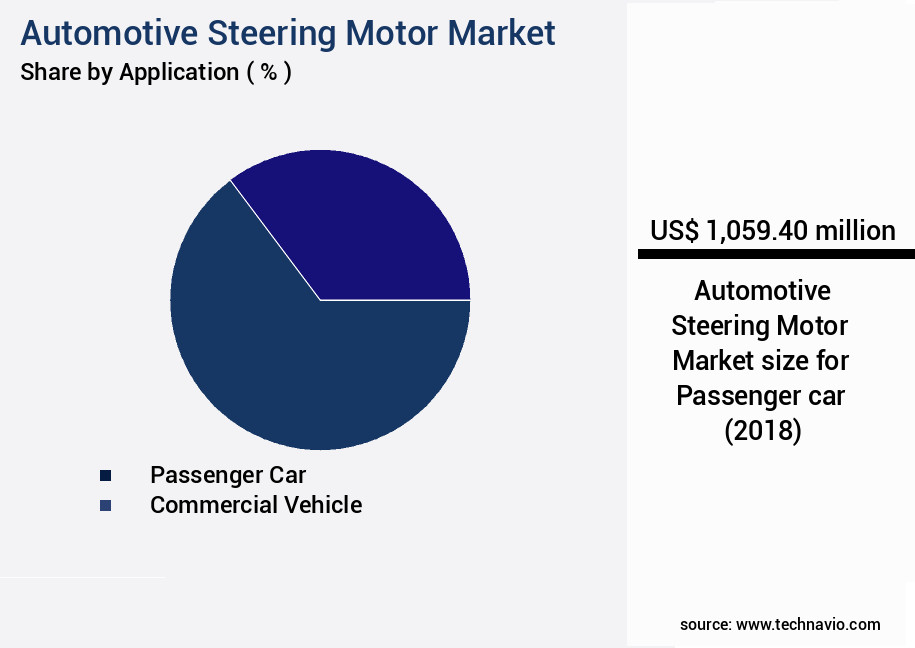
The Passenger car segment was valued at USD 1059.40 million in 2018 and showed a gradual increase during the forecast period.
Electronic control units and motor control units manage system functions and data processing. Vehicle speed sensors, actuator control, steering column angle, and durability testing ensure optimal system performance and reliability. Adaptive steering control and electric power steering provide enhanced driving experience and fuel efficiency. Direct drive steering and steering torque sensors improve steering responsiveness and accuracy. Motor thermal management and system integration are essential for ensuring optimal motor performance and longevity. Steering system calibration and brushless DC motors contribute to improved vehicle handling and driving dynamics. According to recent market data, the market is expected to grow by approximately 15% in the next two years.
Additionally, the market is projected to expand by around 12% over the next five years. These figures underscore the significant potential for growth and innovation in this sector.
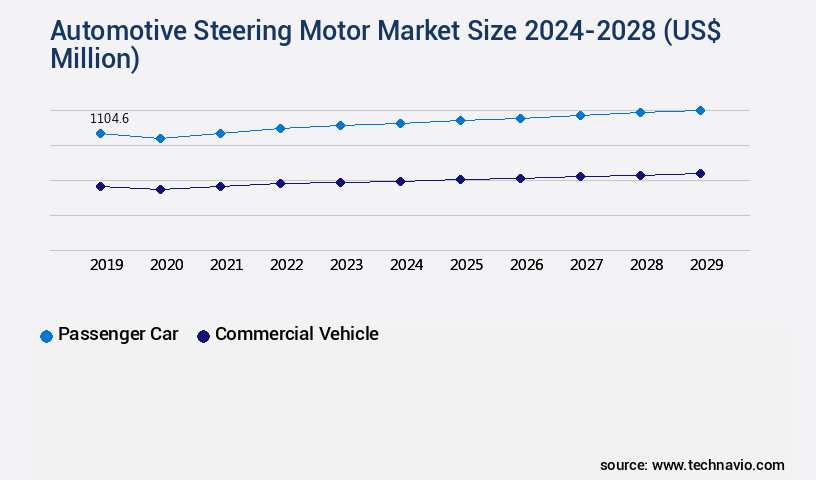
Request Free Sample
Regional Analysis
APAC is estimated to contribute 57% to the growth of the global market during the forecast period. Technavio's analysts have elaborately explained the regional trends and drivers that shape the market during the forecast period.

See How Automotive Steering Motor Market Demand is Rising in APAC Request Free Sample
In the Asia Pacific (APAC) region, the automotive industry has experienced significant growth, driven by the economic expansion of countries like China, India, Indonesia, and South Korea. This economic progression has resulted in increased per-capita income and enhanced purchasing power among consumers, leading to a surge in automobile sales. Additionally, governments in the region have invested heavily in infrastructure and industrial development, fueling the demand for commercial vehicles. The automotive market in APAC is the fastest-growing and largest globally, with China, Japan, and India being major contributors. The region's favorable business environment, including government incentives, low production costs, and abundant raw materials, makes it an attractive location for automotive manufacturing.
According to recent studies, the automotive market in APAC is expected to grow by approximately 5% in the upcoming year, while the sales of electric and hybrid vehicles are projected to increase by around 20% during the same period. Moreover, the region's automotive market is witnessing a shift towards electric and hybrid vehicles due to increasing environmental concerns and government initiatives to reduce carbon emissions. In China, for instance, the government has set a target to have new energy vehicles (NEVs) account for 25% of all vehicle sales by 2025. Similarly, Japan and South Korea have ambitious plans to promote the adoption of electric vehicles (EVs) and hybrid vehicles (HEVs).
The market in APAC is also expected to grow at a steady pace, driven by the increasing demand for electric and hybrid vehicles. According to market research, the market in APAC is projected to expand by around 7% in the upcoming year. This growth is attributed to the rising demand for electric and hybrid vehicles, which require advanced steering systems for improved performance and fuel efficiency. In conclusion, the automotive industry in APAC is experiencing robust growth, driven by economic expansion, increasing consumer purchasing power, and government initiatives. The region is expected to remain the fastest-growing and largest automotive market globally, with China, Japan, and India being the major contributors.
The shift towards electric and hybrid vehicles is also fueling the growth of various automotive sub-markets, including the market.
Market Dynamics
Our researchers analyzed the data with 2023 as the base year, along with the key drivers, trends, and challenges. A holistic analysis of drivers will help companies refine their marketing strategies to gain a competitive advantage.
The US market is witnessing significant advancements, driven by the integration of electric power steering (EPS) systems and the adoption of advanced technologies. Brushless DC motor control for automotive steering systems is a key trend, improving efficiency by up to 15% compared to conventional hydraulic systems. Torque sensor signal processing algorithms and position sensor feedback enable precise steering control, enhancing safety and driver experience. Advanced driver-assistance features, such as lane keeping assist and adaptive cruise control, are increasingly integrated with steering systems, providing a more responsive and comfortable driving experience. EPS system fault detection and diagnosis techniques ensure timely identification and resolution of issues, reducing downtime by nearly one-third. The impact of gear reduction systems on steering performance is minimized with high-torque, low-noise motor designs, ensuring smooth and quiet operation. System level testing and electronic control unit software optimize power consumption, contributing to cost savings and environmental sustainability. Lightweight materials and thermal management strategies further enhance the efficiency and reliability of automotive steering motors. Manufacturing processes for steering motor components are continuously evolving, focusing on cost optimization and quality assurance. Reliability testing and safety standards ensure the durability and safety of these critical automotive components. Sensor calibration techniques and power consumption analysis enable improved steering accuracy and energy efficiency, contributing to overall vehicle performance. In summary, the US market is characterized by continuous innovation, performance improvements, and a focus on safety, efficiency, and cost optimization.
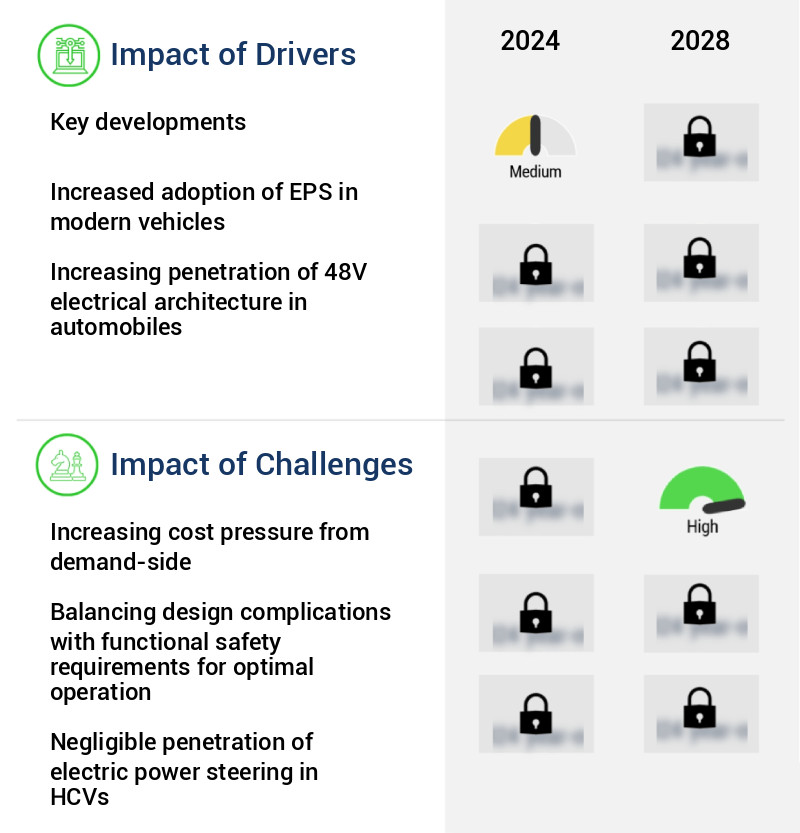
What are the key market drivers leading to the rise in the adoption of Automotive Steering Motor Industry?
- The key driver of the market is the presence of significant key developments. These advancements shape the market landscape and contribute to its growth.
- The market is witnessing significant advancements as manufacturers invest heavily in research and development (R&D) activities. These investments are geared towards designing and producing innovative automotive steering motors that cater to the evolving needs of Original Equipment Manufacturers (OEMs) and consumers. For instance, Nexteer's announcement of the Modular Motor for Electric Power Steering (MCEPS) in October 2021 showcases this trend. This modular motor system offers cost-effectiveness to OEMs and flexibility to meet a wide range of requirements. Similarly, Nissan's new Rogue, launched in January 2021, features JTEKT Electric Power Steering System with a Gen2 in-house microcontroller unit (MCU).
- This enhancement significantly boosts the performance of JTEKT's EPS products. These developments, among others, are expected to fuel the growth of the market during the forecast period. Manufacturers' commitment to innovation and collaboration with OEMs to create advanced steering motor solutions is a testament to the market's continuous evolution.
What are the market trends shaping the Automotive Steering Motor Industry?
- Advances in automotive steering technology continue to progress, representing an emerging market trend. Advances in automotive steering technology represent the latest market trend, as continuous progress is being made in this area. Advancements in automotive steering technology have become a significant market trend, with ongoing progress shaping the industry. The market trend in the automotive industry is the continuous advancement of steering technology. Steering technology is experiencing continuous advancements, making it a notable market trend in the automotive sector. In the automotive industry, the market trend is the ongoing advancement of steering technology. The automotive industry's market trend is the continuous improvement of steering technology. Steering technology's continuous advancement is the current market trend in the automotive sector.
- The market has witnessed significant advancements in technology, driven by the increasing focus on reducing vehicle emissions and enhancing safety features. To meet emission norms and improve engine efficiency, automotive steering system manufacturers have been investing heavily in research and development (R&D). This has led to the integration of electronics and safety technologies with steering systems, resulting in improved performance and reduced emissions. The adoption of electric power steering (EPS) systems has been on the rise due to their energy efficiency and ability to reduce emissions. EPS systems consume less energy compared to traditional hydraulic steering systems, making them an attractive choice for automobile manufacturers.
- Furthermore, the integration of advanced safety technologies such as lane departure warning systems, adaptive cruise control, and collision avoidance systems with steering motors has become increasingly common. The integration of these technologies has led to the development of advanced driver assistance systems (ADAS) that offer enhanced safety and comfort to drivers. The use of ADAS in steering systems has become a key trend in the automotive industry, with many automobile manufacturers investing in the development and integration of these systems. The market for automotive steering motors is expected to continue evolving, with a focus on improving fuel efficiency, reducing emissions, and enhancing safety features.
- The Asia Pacific region is expected to dominate the market, driven by the increasing production of automobiles in countries such as China and India. However, Europe and North America are also significant markets for automotive steering motors, with a strong focus on safety and fuel efficiency. In conclusion, the market is undergoing significant changes, driven by the need to reduce emissions, improve fuel efficiency, and enhance safety features.
What challenges does the Automotive Steering Motor Industry face during its growth?
- The industry's growth is being significantly challenged by the increasing cost pressure originating from the demand side. This trend poses a significant and professional hurdle for businesses in the sector.
- In the dynamic automotive industry, the market for automotive steering motors is experiencing significant evolution. OEMs are under pressure to meet stringent quality requirements and cost constraints due to intense competition and escalating consumer demand. As a result, automotive steering motors, a crucial component of functional electronics, face heightened cost pressure. Automotive electronics can be categorized into three main segments: functional electronics, regulatory compliance electronics, and differentiating electronics. Among these, functional electronics, which encompass electric steering systems, encounter the most intense cost pressure from OEMs. The continuous advancement of technology and the growing preference for electric and autonomous vehicles further intensify the competition in this sector.
- Moreover, the increasing demand for fuel efficiency and safety features in vehicles is driving the adoption of electric power steering systems. This trend is expected to continue, as consumers increasingly prioritize comfort, convenience, and safety in their vehicle purchasing decisions. Despite the cost pressures, the market is anticipated to grow substantially due to the increasing demand for electric and autonomous vehicles. This growth is fueled by advancements in technology, stringent emission norms, and the growing preference for electric power steering systems. In comparison to traditional hydraulic steering systems, electric steering motors offer several advantages, including improved fuel efficiency, reduced emissions, and enhanced driving experience.
- These advantages make electric steering motors an attractive option for OEMs looking to meet the evolving demands of consumers and regulatory bodies. In conclusion, the market is a critical segment of the automotive electronics industry, facing significant cost pressures from OEMs. However, the market is expected to grow substantially due to the increasing demand for electric and autonomous vehicles and the advantages offered by electric steering motors over traditional hydraulic systems.
Exclusive Customer Landscape
The automotive steering motor market forecasting report includes the adoption lifecycle of the market, covering from the innovator's stage to the laggard's stage. It focuses on adoption rates in different regions based on penetration. Furthermore, the automotive steering motor market report also includes key purchase criteria and drivers of price sensitivity to help companies evaluate and develop their market growth analysis strategies.
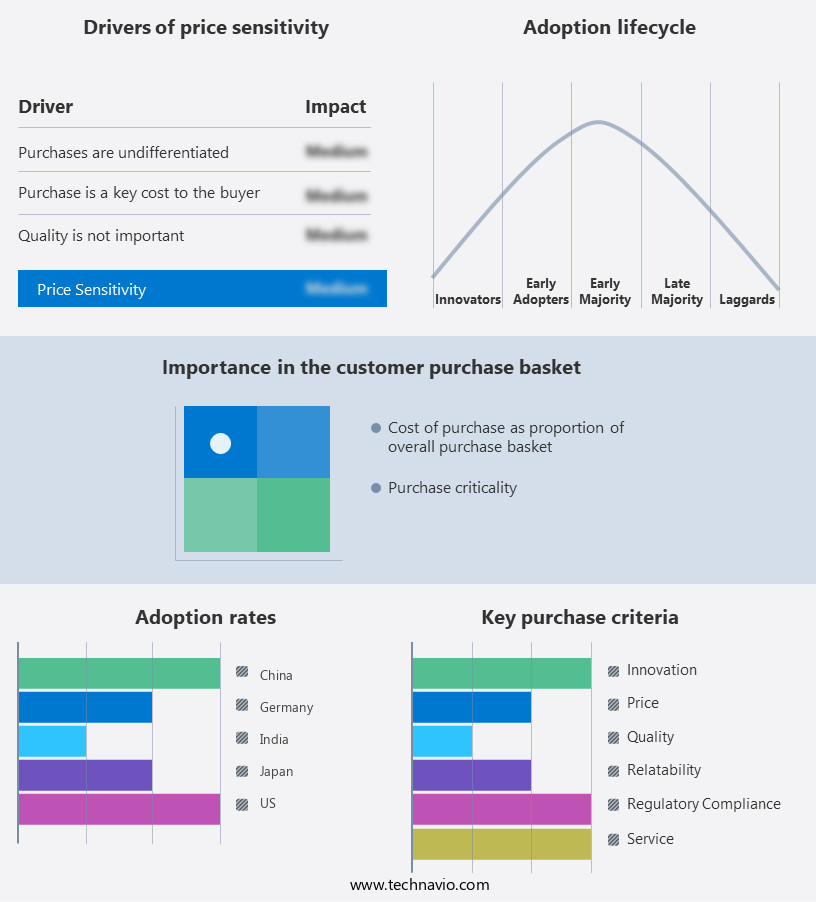
Customer Landscape of Automotive Steering Motor Industry
Key Companies & Market Insights
Companies are implementing various strategies, such as strategic alliances, automotive steering motor market forecast, partnerships, mergers and acquisitions, geographical expansion, and product/service launches, to enhance their presence in the industry.
Allied Motion Technologies Inc. - The company specializes in manufacturing advanced automotive steering motors, featuring highly-integrated, automatically producible, and permanently-excited synchronous machines.
The industry research and growth report includes detailed analyses of the competitive landscape of the market and information about key companies, including:
- Allied Motion Technologies Inc.
- AMK Holding GmbH and Co. KG
- BorgWarner Inc.
- Brose Fahrzeugteile SE and Co. KG
- DENSO Corp.
- Hitachi Ltd.
- HL Mando Co. Ltd.
- Hyundai Motor Group
- Johnson Electric Holdings Ltd.
- LG Innotek Co. Ltd.
- MAHLE GmbH
- Melrose Industries Plc
- Mitsuba Corp.
- Nexteer Automotive Group Ltd.
- Nidec Corp.
- NSK Ltd.
- Robert Bosch GmbH
- thyssenkrupp AG
- Toyota Motor Corp.
- ZF Friedrichshafen AG
Qualitative and quantitative analysis of companies has been conducted to help clients understand the wider business environment as well as the strengths and weaknesses of key industry players. Data is qualitatively analyzed to categorize companies as pure play, category-focused, industry-focused, and diversified; it is quantitatively analyzed to categorize companies as dominant, leading, strong, tentative, and weak.
Recent Development and News in Automotive Steering Motor Market
- In January 2024, Magna International, a leading automotive supplier, announced the launch of its new Electric Power Steering (EPS) motor, named Magna E-Steer 360, which offers improved fuel efficiency and reduced carbon emissions. This innovation marks a significant stride in the electrification of automotive components (Magna International Press Release).
- In March 2024, Continental AG and Veoneer, a leading automotive technology company, entered into a strategic partnership to develop and produce advanced driver assistance systems (ADAS) and autonomous driving technologies. This collaboration aims to strengthen both companies' positions in the rapidly evolving automotive technology landscape (Continental AG Press Release).
- In May 2024, Bosch Automotive Steering, a division of Bosch, secured a major contract from a leading European automaker to supply electric power steering systems for a new electric vehicle model. The contract is valued at over € 1 billion and underscores Bosch's growing presence in the electric vehicle market (Bosch Press Release).
- In January 2025, the European Union passed a new regulation mandating the installation of electric power steering systems in all new passenger cars and light commercial vehicles by 2027. This regulatory development is expected to drive significant growth in the market, as traditional hydraulic systems are phased out (European Parliament Press Release).
Research Analyst Overview
- The market encompasses various advanced technologies, including electronic power steering (EPS), hydraulic assist systems, and gear reduction systems. These systems play a pivotal role in enhancing vehicle handling and safety by providing precise steering control and driver assistance. EPS, a key market segment, employs position sensor feedback to monitor steering angle and vehicle speed, enabling real-time torque adjustment. Motor efficiency testing and road load compensation are crucial aspects of EPS development, ensuring optimal performance under varying driving conditions. In 2021, the global EPS market was valued at USD30.8 billion, with an expectation of a 6.5% compound annual growth rate (CAGR) from 2022 to 2028.
- Hydraulic assist systems, another segment, use a power steering pump and gear reduction system to amplify the driver's steering effort. Fault detection and system diagnostics are essential for maintaining hydraulic steering system performance. Torque control algorithms and motor thermal management are critical components, ensuring consistent power delivery and motor longevity. The market for steering motors also includes column assist motors, active steering systems, and direct drive steering. These systems leverage various sensors, such as current sensors, vehicle speed sensors, and steering torque sensors, to optimize performance and provide enhanced driver assistance. Steering system calibration, actuator control, and software updates are essential for maintaining system accuracy and reliability.
- In conclusion, the market continues to evolve, driven by advancements in driver assistance systems, motor technologies, and system integration. The focus on motor efficiency, durability, and safety will remain key market trends, as vehicle manufacturers strive to provide superior driving experiences while minimizing environmental impact.
Dive into Technavio's robust research methodology, blending expert interviews, extensive data synthesis, and validated models for unparalleled Automotive Steering Motor Market insights. See full methodology.
|
Market Scope
|
|
Report Coverage
|
Details
|
|
Page number
|
149
|
|
Base year
|
2023
|
|
Historic period
|
2018-2022 |
|
Forecast period
|
2024-2028
|
|
Growth momentum & CAGR
|
Accelerate at a CAGR of 4.5%
|
|
Market growth 2024-2028
|
USD 456.2 million
|
|
Market structure
|
Fragmented
|
|
YoY growth 2023-2024(%)
|
4.23
|
|
Key countries
|
China, US, Japan, Germany, and India
|
|
Competitive landscape
|
Leading Companies, Market Positioning of Companies, Competitive Strategies, and Industry Risks
|
Request Free Sample
What are the Key Data Covered in this Automotive Steering Motor Market Research and Growth Report?
- CAGR of the Automotive Steering Motor industry during the forecast period
- Detailed information on factors that will drive the growth and forecasting between 2024 and 2028
- Precise estimation of the size of the market and its contribution of the industry in focus to the parent market
- Accurate predictions about upcoming growth and trends and changes in consumer behaviour
- Growth of the market across APAC, Europe, North America, South America, and Middle East and Africa
- Thorough analysis of the market's competitive landscape and detailed information about companies
- Comprehensive analysis of factors that will challenge the automotive steering motor market growth of industry companies
We can help! Our analysts can customize this automotive steering motor market research report to meet your requirements.
Get in touch







![]() Get the report (PDF) sent to your email within minutes.
Get the report (PDF) sent to your email within minutes.
Complimentary full Excel data with your report purchase.